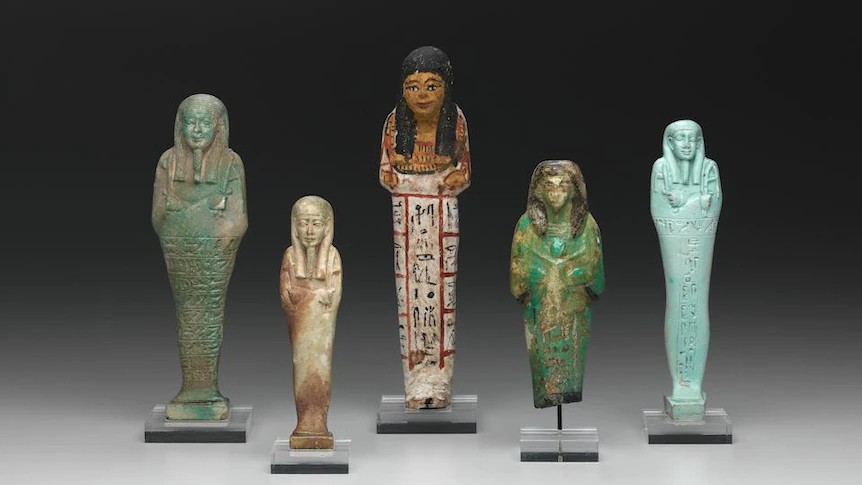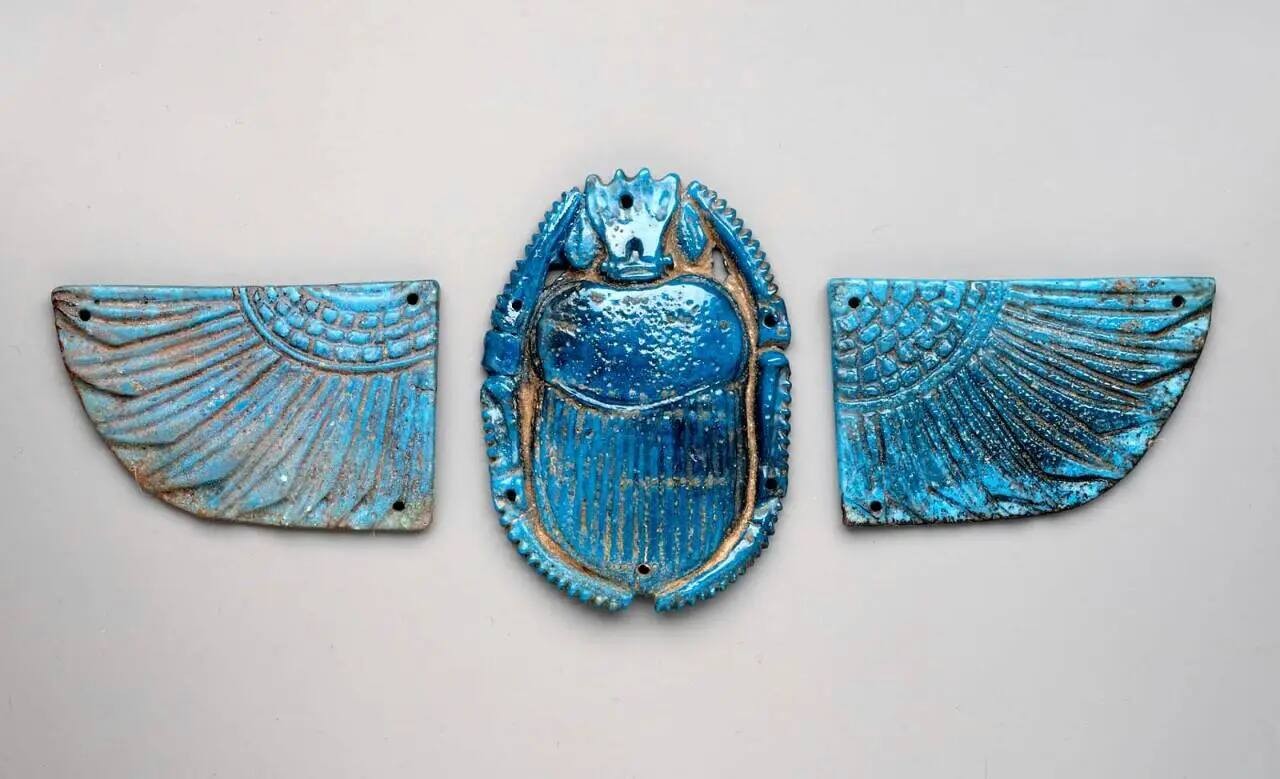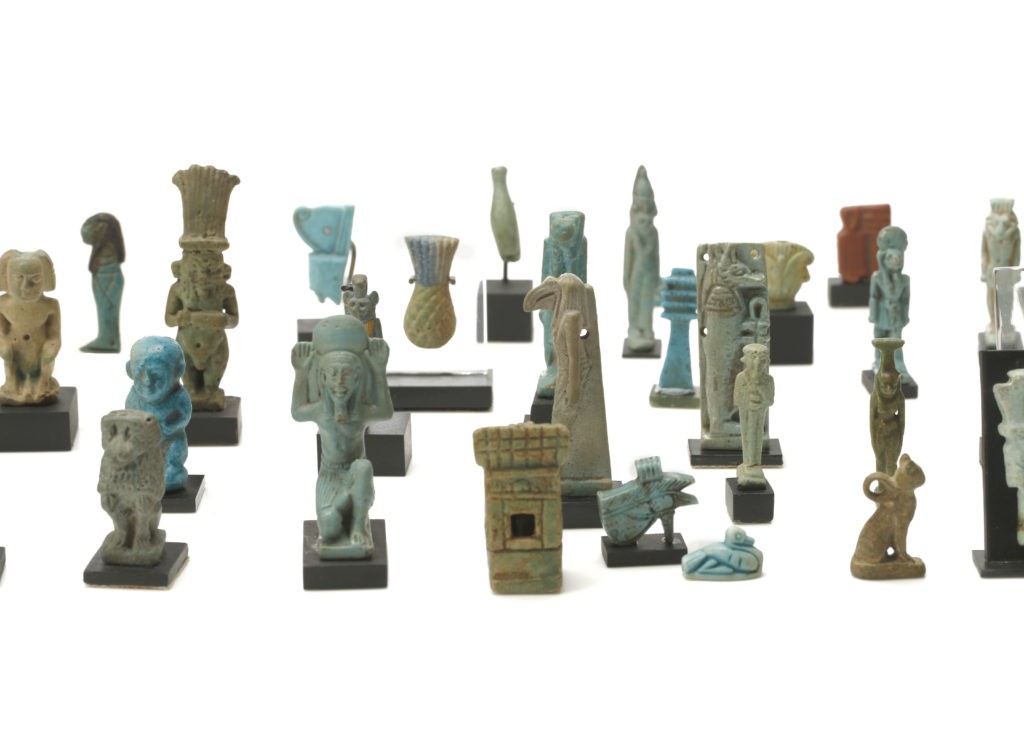AMULET An amulet is anything worn or carried by a person for protection or good luck. In ancient Egypt, amulets were often small figures of the gods. Of all the magical objects used by the Egyptians, amulets were by far the most popular. Newborns were adorned with amulets to keep them safe and healthy, and parents placed amulets around their children's necks to ward off evil spirits and protect them from scorpions, snakes, and crocodiles.
Amulets, which were created in many variations, were thought to possess a variety of abilities. Some amulets have divine power and served only as protection. Bastet, the cat goddess, would defend you, for instance, if you wore a little cat charm around your neck. A lion amulet would make you bold, a bull amulet would give you strength, and an ibis or baboon amulet would aid you in gaining wisdom and understanding, according to the Egyptians, who also thought that some amulets provided the user extraordinary abilities in addition to keeping them safe.
One of the most popular Egyptian amulets was the EYE OF HORUS, which was worn by the living for good health and also placed on the dead for regeneration. The Eye of Horus is shaped like a stylized falcon's eye, and the Egyptian word for it is unjust, or sound eye. good health and also placed on the dead for regeneration. The Eye of Horus is shaped like a stylized falcon's eye, and the Egyptian word for it is unjust, or sound eye. Faience amulets were produced in workshops all over Egypt. The first step was to prepare a mold.

A master amulet was carved, usually in stone, and pressed into a lump of soft clay. The clay was baked or fired until it was hard, and that became the mold used to make amulets. Any number of molds could be made from the master amulet, and any number of amulets could be made from each mold. A small lump of faience was rolled into a ball around a string and pressed into the mold. When the mold was fired, the paste hardened and the string burned away, leaving a hole so the amulet could be strung on a cord. Faience amulets came in many colors, but the ancient Egyptians favored shades of turquoise and blue.
Amulets changed over Egypt's 3,000-year history. Those from the Old Kingdom (2686 - 2181 B.C) tended to be hawks, hippopotami, or lions. Later, in the First Intermediate period (2181 - 2055 B.C), amulets were often in the shape of body parts: arms, hands, feet, hearts, and eyes. The Middle Kingdom produced one of ancient Egypt's most popular amulets, one that is still worn today: the SCARAB beetle.
Amulets from the New Kingdom featured the most well-liked deities. Often, they were inlaid in other types of jewellery or hung on a thread around the neck. Favorites included AMUN ISIS, HATHOR, BES, and TAURET.
Funerary Amulets Some amulets were made to ensure that the mummy remained intact and had the power to resurrect in the next world. The MacGregor Papyrus, a version of the BOOK OF THE DEAD, lists 75 funerary amulets and their uses. The list requires that each amulet be made of gold. Since gold doesn't tarnish, it seemed the most enduring material to protect the mummy for eternity.
One of the most important funerary amulets was the DJED PILLAR, called the backbone of Osiris, which represents stability for the deceased. Chapter 155 in the Book of the Dead calls for a pillar of gold to be placed on the throat of the mummy, but often a string of faience or bone DJed amulets was used because gold was too costly.
Another important funerary amulet was the tet or the KNOT OF ISIS, sometimes called the Girdle of Isis or the Blood of Isis. During the Greek and Roman periods (332 B.C - A.D 395), Isis was identifiable by the distinctive knot on the front of her gown. The tet is often carved from a hard red stone like jasper or carnelian or sometimes molded in red glass. The Book of the Dead suggests the tet should be made of red jasper and dipped into the sap of the ankh-my plant. This plant is not known today, but the name suggests magical power, for it means overseer of life. The ancient Egyptians believed that if the tet was inlaid in sycamore wood and placed on the mummy's neck, the power of Isis would protect him or her.

A group of amulets called the FOUR SON OF HORUS were essential for the mummy. All four deities have the body of a man, but each has a different head. Messi is human-headed, Hapi is ape-headed, Duamutef is jackal-headed, and Qebesenef is falcon-headed. Amulets of these four gods were usually made of blue faience and had several holes on each side so they could be sewn onto the mummy wrappings. They were almost always placed across the mummy's chest. Often, a miniature headrest made of hard stone was placed in the mummy wrappings to protect the head of the mummy and to help him or her arise to the next world. Small heart amulets were sometimes wrapped with the mummy to protect the heart and ensure that it did not speak against the deceased when he or she made a plea before the gods.
| Aegis | Miniature of a broad collar necklace with the head of a god worn for protection |
| Bastet | The cat-headed household goddess who brought good luck |
| Bes | The grotesque dwarf god who brought good luck to families |
| Eye of Horus | Eye of the falcon god Horus, worn for good health |
| Isis | The greatest Egyptian goddess, who was the Keeper of Secrets |
| Isis Suckling the Infant Horus | For the protection of mother and child |
| Hathor | Cow-headed goddess of music and dance |
| Horus Falcon | headed protector god |
| Maat | Goddess of truth justice, whose attribute was the feather of truth |
| Nefertum | The god of the blue lotus blossom |
| Nekhbet | The vulture goddess who protected the pharaoh |
| Nephthys | The lady of the mansion and sister of Isis |
| Ptah | The god of craftsmen, and a creator god Ptah Dwarf god protector of children |
| Scarab | Beetle whose image means to exist for protection and to give long life |
| Tauren | Pregnant hippopotamus, for protection during childbirth |
| Thoth | Ibis-headed god of writing and wisdom |
Find out our latest news, promotions, and professional tips. Know before you book your next Egypt tours
Egypt has many historical sites that you can visit and enjoy. Each tour is different and unique. If you go on a Nile cruise, you can visit Abu Simbel, Aswan, and Luxor in the South and enjoy the temples, tombs, and the treasures of the Nile. In the North, enjoy the Pyramids of Giza, The Egyptian Museum, Sakkara. Mosques, churches in Cairo, and many landmarks located in the city of Alexandria. On the East, Enjoy a beach tour for diving, snorkeling, and swimming in the Red sea. Every city has its charm, history, and flavor where you can do many tours and activities.
Your Egypt Tours is one of the leading and pioneer travel agencies in the Egyptian tourism industry. We offer very special care and personal touch to our clients making them feel at home with their family. Great and high-quality service to ensure that your trip with us is one of a lifetime. In addition, the commonly known reasons such as our customers’ feedback and testimonials, competitive prices - excellent customer service, punctuality and. Most important of all, our customers safety and enjoying every minute in your trip are our priorities. With us, you are in a safe hand.
It usually varies according to the type of tourist trip in Egypt, but the average cost for spending one week in Egypt is 1600 USD including visiting alot of tombs and temples and sailing on a 4 or 5 stars Nile cruise.
Don't drink the tap water - it is highly chlorinated. However, with enough time in Egypt, you could potentially grow accustomed to the water. This doesn't mean that the tap water is polluted, it simply means that you are not used to it, and you might get stomach problems. This happened to most people when they visit a country for the first time. They were simply not used to water there. It's a similar situation here. It is advisable to drink Bottled water during your entire holiday. That is why it is strongly advisable that you don't drink the tap water, and use it only for washing and brushing your teeth.
Enjoy Egypt Tours From September until March. It is the perfect time when the weather is good and mild. From September until mid-November, when it is very nice and the temperatures are pleasant for all activities - around 25 C to 15 C. mid-Nov until the end of February is wintertime when temperatures during the day are around 12 or 15 C, and at night can drop to about 7 or 8 C. In March and April, the weather is still so nice and travelers can enjoy the Easter vacation. From May to September is the summer season. Spending summertime in a desert climate does not appeal to most travelers. Average daytime temperatures hover in the high 80s and low to mid-90s, although they can jump up into three digits in the South as in Luxor and Aswan. Summer is really hot here, prices go down and it is a good chance for travelers with a tight budget.
It is usually hot and sunny. winter falls between November and January, and the peak of the summer months is between June and August. Winters are generally mild, although temperatures can fall below 50 degrees Fahrenheit (10 degrees Celsius) at night. In the Western Desert. Cairo and areas of the Nile Delta may experience a few rainy days during winter. Summers can be unbearably hot, especially in the desert and other areas of the country's interior. In Cairo, average summer temperatures regularly exceed 86 degrees Fahrenheit (30 degrees Celsius), while the record high for Luxor and Aswan, popular tourist destinations on the banks of the River Nile, is 110 degrees Fahrenheit (45 degrees Celsius).
Safety and security are our first and foremost concerns! Egypt is a very safe country with a low crime rate. Now with the coronavirus outbreak, accommodations and sightseeing nationwide have finalized sterilization and disinfection in light of the Egyptian government's efforts to implement precautionary measures against the COVID-19. In addition, our company has followed the same procedures to make all our staff, guides, and drivers are well-trained with the current events to prevent and stop the spread of this outbreak. Traveling the world is a joyful experience and we want to do our part to keep the anticipation stress-free.
There are many things to do in Egypt during your visit depending on your interests and character. Cairo, Alexandria, Luxor, and Aswan Nile cruise must be your first priority if you are a history and culture lover. You must visit the pyramids of Giza, enjoy a Nile cruise between Luxor and Aswan and enjoy visiting the most important tourist attractions in Luxor and Aswan. You can visit the city of Hurghada, Marsa Alam, or Sharm el-Sheikh Red Sea for relaxation and enjoy many activities there such as diving, snorkeling, sunbathing, or swimming. You may like to go on a safari trip in the western desert if you are an adventurer. Many other activities are available in every single Egyptian city
The high season for tourism is all year with winter and spring being peak season for cultural travels with lots of sightseeing. Weather in Egypt is perfect for many kinds of tourism, and if coming in June, July, and August, head for the seaside resorts. Those months are very warm with temperatures that can reach around 45C. and the humidity is about 70 to 80%, but it is bearable with the sea and large swimming pools nearby. So the period of the high summer season is also a bit busy as hotels fill up with tourists from all over the world looking for a bargain, lots of sunshine, diving, snorkeling, etc. It is also a primary vacation time in Europe. If you come in the deep summer season you can still enjoy it because you can always sightsee early in the morning and go again at night when the sunsets. You will definitely need good sunscreen and a lot of liquids to drink with a nice hat on your head. Summer is a good time for people looking for good rates in accommodation and other services.
Egypt is a Muslim country and the dress code is towards the conservative side, especially for women. That being said, we are used to seeing travelers from all over the world. My suggestion would be to wear light clothes and not to wear short shorts, short skirts and alike to avoid the occasional unwanted stare. But it's really up to you. When you visit religious places (synagogues, churches, and mosques) you do need to cover your shoulders and wear over the knee dresses, if you are planning to wear one of course. If you plan to attend the Nile dinner cruise, there is no need for formal wear unless you want to make that night a special night! Also, you will be sharing this experience with other travelers so you can dress however you feel most comfortable.
You can get your visa when you arrive at Cairo Airport. It is an easy process for USA, UK, Canadian, Australian and European citizens. The visa is simply a stamp (like a mail or postage stamp) that you buy from the visa office, at the port of entry just before the immigration booth. The visa will cost you $25 US Dollars and after buying it; you just stick it on any empty page on your passport. Once you have bought your visa you then stand in line to get your passport stamped by the immigration officer. You can also apply for E-Visa via the official electronic visa portal: www.visa2egypt.gov.eg
Your Egypt Tours travel agency recommends two weeks so that you can enjoy the temples and tombs of Luxor and Aswan, explore the sights of Cairo, and relax in the Red Sea islands and nature reserves.
There are many Nile cruises. Not to name one but your choice depends on many things to put in mind such as the number of nights you want to spend on the cruiser, your budget, and the standard of the Nile cruise. We recommend you choose a 5-star luxury Nile cruise, and if you are looking for a private Nile River cruise you can choose Dahabiya cruises, it is only for the small-group tour, about 15 people. Most cruises have. There is another way of cruising the Nile, which is the Felucca boat. It is traditional and charming but it is cheap as long as it will be ok to sleep on the deck exposed to mosquitos and most of these boats do not have a toilet
The best time to visit Egypt is generally from October to April where it is suitable for outdoor activities and sightseeing.
Egypt travel usually have guided tours to archaeological sites, museums, and historical landmarks. Also have optional activities may include hot air balloon rides over Luxor, snorkeling in the Red Sea, or desert safaris.
Travel has helped us to understand the meaning of life and it has helped us become better people. Each time we travel, we see the world with new eyes.
